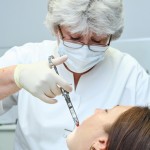
Unfortunately for patients with irreversible pulpitis inferior alveolar nerve block (IANB) is not always successful in achieving satisfactory levels of anaesthesia. The aim of this study was to compare the efficacy of supplementary repeat inferior alveolar nerve block with 2% lidocaine and epinephrine, buccal infiltration with 4% articaine with epinephrine, intraligamentary injection, or intraosseous injection (both with 2% lidocaine with epinephrine) after failed inferior alveolar nerve block (IANB) for securing pain-free treatment in patients experiencing irreversible pulpitis in mandibular permanent teeth.
What did they do
Patients in whom the initial IANB did not secure pulpal anaesthesia within 10 minutes or those who felt pain during their treatment were randomised to receive 1 of 4 supplementary local anaesthetic injections.
- Repeat lidocaine IANB (rIANB) (2.0 mL of 2% lidocaine HCL with 1:80,000 epinephrine)
- Buccal infiltration (ABI) (2 mL of 4% articaine HCL with epinephrine 1:100,000)
- Intraligamentary injection (PDL), using a specialized intraligamentary syringe fitted with an ultra-short needle(0.18 mL of 2% lidocaine with 1:80,000 epinephrine for each root)
- Intraosseous anaesthesia (IO) (1mL of lidocaine (2%) with epinephrine 1:80,000)
Successful pulp anaesthesia was considered to have occurred when no response was obtained to the maximum stimulation (80 reading) of the pulp tester, at which time treatment commenced. Treatment was regarded as being successfully completed when it was associated with no pain.
What did they find
Of the 182 patients, 122 achieved successful pulpal anaesthesia within 10 minutes after initial IANB injection; 82 experienced pain-free treatment.
ABI and IO allowed more successful (pain-free) treatment (84% and 68%, respectively) than rIANB or PDL supplementary techniques (32% and 48%, respectively); this was statistically significant (P = .001).
They concluded
IANB injection alone does not always allow pain-free treatment for mandibular teeth with irreversible pulpitis. Supplementary buccal infiltration with 4% articaine with epinephrine and intraosseous injection with 2% lidocaine with epinephrine are more likely to allow pain-free treatment than intraligamentary and repeat IANB injections with 2% lidocaine with epinephrine for patients experiencing irreversible pulpitis in mandibular permanent teeth.
Kanaa MD, Whitworth JM, Meechan JG. A prospective randomized trial of different supplementary local anesthetic techniques after failure of inferior alveolar nerve block in patients with irreversible pulpitis in mandibular teeth.J Endod. 2012 Apr;38(4):421-5. Epub 2012 Feb 2. PubMed PMID: 22414822.
